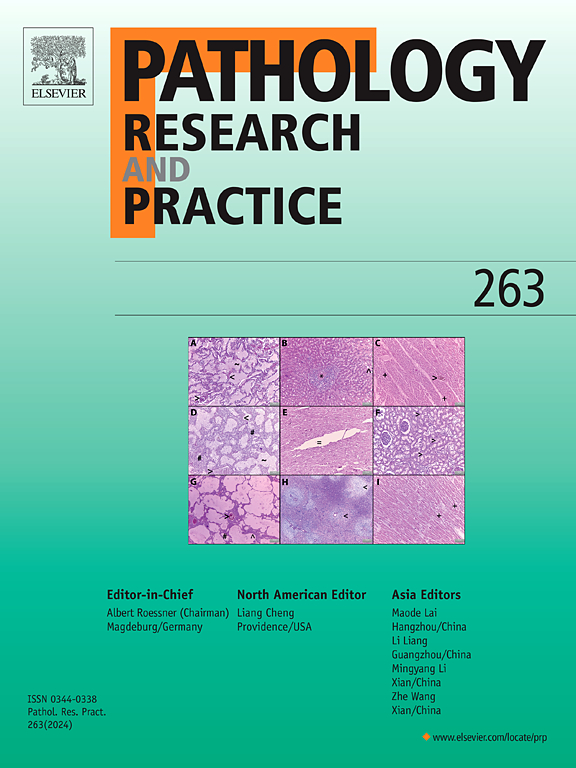Eosinophilic solid and cystic renal cell carcinoma: A case with two novel TSC2 mutations
IF 2.9
4区 医学
Q2 PATHOLOGY
引用次数: 0
Abstract
Background
Eosinophilic solid and cystic renal cell carcinoma (ESC RCC) is a recently identified subtype of renal tumors. Due to its rarity, pathologists currently have a limited understanding of its clinical and pathological characteristics, which increases the risk of misdiagnosis.
Case report
In this paper, we present a case of a 21-year-old male diagnosed with eosinophilic solid and cystic renal cell carcinoma that is more common in females. Histologically, the tumor appears solid-cystic at low magnification, featuring polygonal tumor cells with high-grade nuclei and abundant eosinophilic cytoplasm. Eosinophilic or basophilic globules are observable within the cytoplasm. Foamy histocytes are clustered among the tumor cells. The cysts are lined by tumor cells arranged in a hobnail pattern. Immunohistochemistry results indicate the expression of CK20, AMACR, Cathepsin K, PAX8 and MelanA, while CK7, CD117, CAIX, TFE3, and HMB45 are negative. There is no loss of SDHB and FH. Molecular analysis identified c2158A>T and c.1258–2 A>T mutations in the TSC2 gene. The patient was followed up for two months without any disease progression.
Conclusion
By detailing the distinctive morphology, immunophenotype, and molecular traits of this ESC RCC case, we have outlined the histological, immunohistochemical, and molecular features of this new renal tumor type, and reviewed relevant literatures for a comprehensive understanding. Our findings expand current knowledge of ESC RCC and can assist in reducing misdiagnosis.
求助全文
约1分钟内获得全文
求助全文
来源期刊
CiteScore
5.00
自引率
3.60%
发文量
405
审稿时长
24 days
期刊介绍:
Pathology, Research and Practice provides accessible coverage of the most recent developments across the entire field of pathology: Reviews focus on recent progress in pathology, while Comments look at interesting current problems and at hypotheses for future developments in pathology. Original Papers present novel findings on all aspects of general, anatomic and molecular pathology. Rapid Communications inform readers on preliminary findings that may be relevant for further studies and need to be communicated quickly. Teaching Cases look at new aspects or special diagnostic problems of diseases and at case reports relevant for the pathologist''s practice.

 求助内容:
求助内容: 应助结果提醒方式:
应助结果提醒方式:


